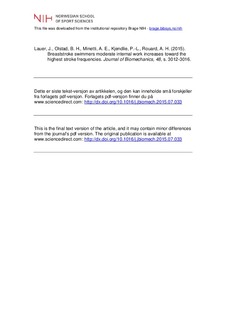| dc.contributor.author | Lauer, Jessy | |
| dc.contributor.author | Olstad, Bjørn Harald | |
| dc.contributor.author | Minetti, Alberto Enrico | |
| dc.contributor.author | Kjendlie, Per-Ludvik | |
| dc.contributor.author | Rouard, Annie Hélène | |
| dc.date.accessioned | 2016-09-13T11:58:06Z | |
| dc.date.available | 2016-09-13T11:58:06Z | |
| dc.date.issued | 2015-09-18 | |
| dc.identifier.citation | Journal of Biomechanics. 2015, 48, 3012-3016 | nb_NO |
| dc.identifier.uri | http://hdl.handle.net/11250/2406741 | |
| dc.description | Dette er siste tekst-versjon av artikkelen, og den kan inneholde små forskjeller
fra forlagets pdf-versjon. Forlagets pdf-versjon finner du på
www.sciencedirect.com /
This is the final text version of the article, and it may contain minor differences
from the journal's pdf version. The original publication is available at
www.sciencedirect.com | nb_NO |
| dc.description.abstract | A model to predict the mechanical internal work of breaststroke swimming was designed. It allowed us to explore the frequency–internal work relationship in aquatic locomotion. Its accuracy was checked against internal work values calculated from kinematic sequences of eight participants swimming at three different self-chosen paces. Model predictions closely matched experimental data (0.58±0.07 vs 0.59±0.05 J kg−1 m−1; t(23)=−0.30, P=0.77), which was reflected in a slope of the major axis regression between measured and predicted total internal work whose 95% confidence intervals included the value of 1 (β=0.84, [0.61, 1.07], N=24). The model shed light on swimmers ability to moderate the increase in internal work at high stroke frequencies. This strategy of energy minimization has never been observed before in humans, but is present in quadrupedal and octopedal animal locomotion. This was achieved through a reduced angular excursion of the heaviest segments (7.2±2.9° and 3.6±1.5° for the thighs and trunk, respectively, P<0.05) in favor of the lightest ones (8.8±2.3° and 7.4±1.0° for the shanks and forearms, respectively, P<0.05). A deeper understanding of the energy flow between the body segments and the environment is required to ascertain the possible dependency between internal and external work. This will prove essential to better understand swimming mechanical cost determinants and power generation in aquatic movements. | nb_NO |
| dc.language.iso | eng | nb_NO |
| dc.publisher | Elsevier | nb_NO |
| dc.subject | mechanical energy | nb_NO |
| dc.subject | swimming | nb_NO |
| dc.subject | predictive equation | nb_NO |
| dc.subject | quadrupedal locomotion | nb_NO |
| dc.title | Breaststroke swimmers moderate internal work increases toward the highest stroke frequencies | nb_NO |
| dc.type | Journal article | nb_NO |
| dc.type | Peer reviewed | nb_NO |
| dc.subject.nsi | VDP::Technology: 500 | nb_NO |
| dc.identifier.doi | http://dx.doi.org/10.1016/j.jbiomech.2015.07.033 | |
| dc.description.localcode | Seksjon for fysisk prestasjonsevne / Department of Physical Performance | nb_NO |
